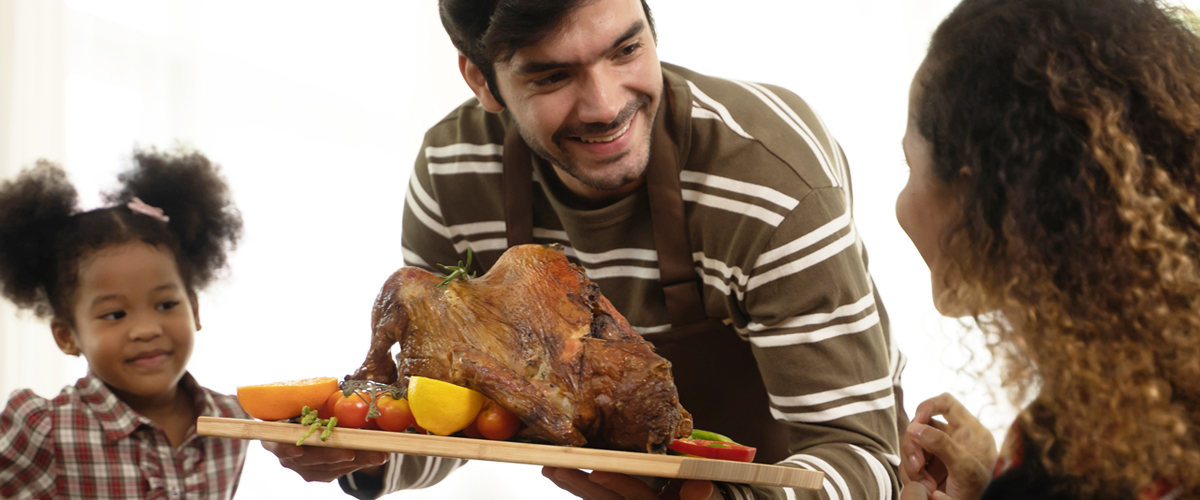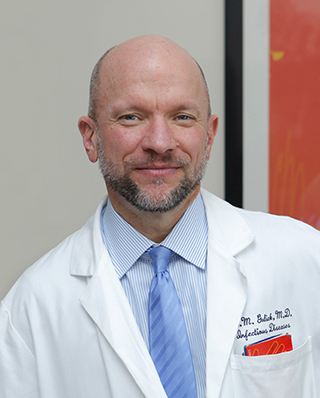Tips to Celebrate Thanksgiving Safely
An infectious disease specialist explains how to protect yourself and your loved ones while enjoying the holiday.

Thanksgiving is a special time of year that traditionally includes traveling to see family and friends for festive get-togethers and a big meal. This year, however, as cases of COVID-19 continue to rise across the country, the holiday will likely look very different.
According to the Centers for Disease Control and Prevention (CDC), small household gatherings contribute greatly to the spread of COVID-19. With the U.S. currently averaging about 158,000 new coronavirus infections a day, “it is vital that Americans rethink Thanksgiving plans during the COVID-19 pandemic and modify how to safely celebrate the holiday,” says Dr. Roy M. Gulick, chief of the Division of Infectious Diseases at NewYork-Presbyterian/Weill Cornell Medical Center and professor of medicine at Weill Cornell Medicine.
“This may be a very different Thanksgiving than any other we’ve ever had, but the threat is real and people really need to take COVID seriously,” says Dr. Gulick.
Health Matters spoke with Dr. Gulick, the Rochelle Belfer Professor in Medicine at Weill Cornell Medicine, who shared safety tips for a pandemic Thanksgiving, as well as a few creative ways to celebrate.

Dr. Roy M. Gulick
Avoid Travel
“Personally, Thanksgiving is my favorite holiday, but I’m staying home,” says Dr. Gulick. “I would typically go to my sister’s in Washington, D.C., and we’d have the whole family over, but we’ve decided not to do that this year.” The CDC has urged Americans to avoid travel, issuing guidance that states that “the safest way to celebrate Thanksgiving is to celebrate at home with the people you live with.” Staying home is the best way to help curb the spread of COVID-19 because any form of travel puts people at risk for exposure. For example, a long drive usually includes visiting a rest stop or gas station, while taking a train, bus, or plane requires being with big groups of fellow travelers for extended periods.
Keep Gatherings Small and the Duration Short
The CDC recommends that people keep their gatherings as small as possible and preferably with just the people in your household for the lowest risk of spread. “Reducing the number of people who are coming from elsewhere, as painful as that can be, is crucial,” says Dr. Gulick. “It’s important to limit the size of the group and the duration that you’re together.”
If gathering from different households, individuals should remain at least 6 feet apart at all times, avoid direct contact (that includes hugs and handshakes, although a careful elbow bump is OK!), and wear a mask except when eating or drinking.
It’s also worth noting that college students who have been away at school should be considered part of different households, should take extra precautions, and, if possible, quarantine for 14 days before seeing family.
Gather Outside, if Possible
Air circulation is better outside than inside, so if you can, have Thanksgiving outdoors. Because of the weather, a picnic dinner may not be possible. If you’re stuck inside, “avoid poor ventilation by turning on the central heating or air conditioner, opening some windows and doors — anything to ensure there’s plenty of air circulation,” suggests Dr. Gulick.
No Potlucks
If attending a gathering, the CDC suggests bringing food and drinks for yourself and the members of your household, and avoid sharing dishes with others. You may also want to bring your own disposable plates and utensils. While Dr. Gulick notes that sharing food and serving utensils is not a common way for COVID-19 to be transmitted, people may feel safer taking this precaution and knowing their dish was prepared safely.
Get Creative
Spending this Thanksgiving solo doesn’t mean you have to be alone in spirit. “We’ll have to get creative with how we celebrate,” adds Dr. Gulick. “If you have a big family and you’re all in town for Thanksgiving but live in separate households, a fun way to celebrate is for each household to make their favorite dish, then deliver it on the doorstep of each other’s houses. Once everyone is home again, they can enjoy the courses together virtually.”
Here are some other lower-risk ways to celebrate:
- Hold a small household Turkey Trot the morning of Thanksgiving. Instead of going with a big group, choose one or two family members to run or bike with.
- Watch the Macy’s Thanksgiving Day Parade with family over Zoom.
- Share a fun cocktail recipe and toast each other during a virtual cocktail hour.
- Virtually gather with family and friends while eating Thanksgiving. (Zoom is lifting its 40-minute time limit for large meetings.)
- Go on a socially distanced walk together after the big meal to get some fresh air and exercise.
Get a Flu Shot
This may not be an ordinary Thanksgiving tradition, but everyone should aim to get the flu vaccination this year before the holidays. “The last thing you want is for people to get two infections at once,” adds Dr. Gulick. “And we know that the flu vaccine will help prevent influenza.”
Remember the “3 W’s”
Just because it’s Thanksgiving doesn’t mean you can do away with the basic safety precautions that have been in effect since the start of the pandemic, especially if gathering together. Dr. Gulick refers to these as the “3 W’s”:
- Wear a mask.
- Wash your hands.
- Watch your distance and keep 6 feet apart.

Protect High-Risk Individuals
It’s important to continue to protect those who are most at risk; this includes elderly individuals. According to Dr. Gulick, older people should not attend any gatherings with outside households this Thanksgiving season. “The older, the greater the risk,” he adds. “Also, people with underlying medical conditions — diabetes, heart disease, kidney disease, cancer, other immunodeficiencies — should be super-careful and avoid gatherings that might expose them to COVID.”
Take Care of Your Mental Health
Social isolation and being away from loved ones is hard. Recognize that this year will be different, but don’t let it keep you from connecting virtually. Practicing gratitude can also help if you’re feeling extra sad — it’s Thanksgiving after all! “We should still give thanks, but remember that the situation is widespread and it is very serious,” reminds Dr. Gulick. “By modifying our behaviors this year, we can hopefully all be together again for next Thanksgiving.”
The CDC has more tips on how to have a safe and healthy Thanksgiving.
Roy M. Gulick, M.D., is chief of the Division of Infectious Diseases at NewYork-Presbyterian/Weill Cornell Medical Center and the Rochelle Belfer Professor in Medicine at Weill Cornell Medicine. Board certified in internal medicine and infectious diseases, Dr. Gulick conducts clinical research, sees patients with infectious diseases, and teaches medicine. His primary research involves designing, conducting, and analyzing clinical trials to refine strategies for HIV treatment and prevention (and more recently, COVID-19). He currently serves as principal investigator of the Weill Cornell HIV Clinical Trials Unit of the AIDS Clinical Trials Group and the HIV Prevention Trials Network, sponsored by the National Institutes of Health.
